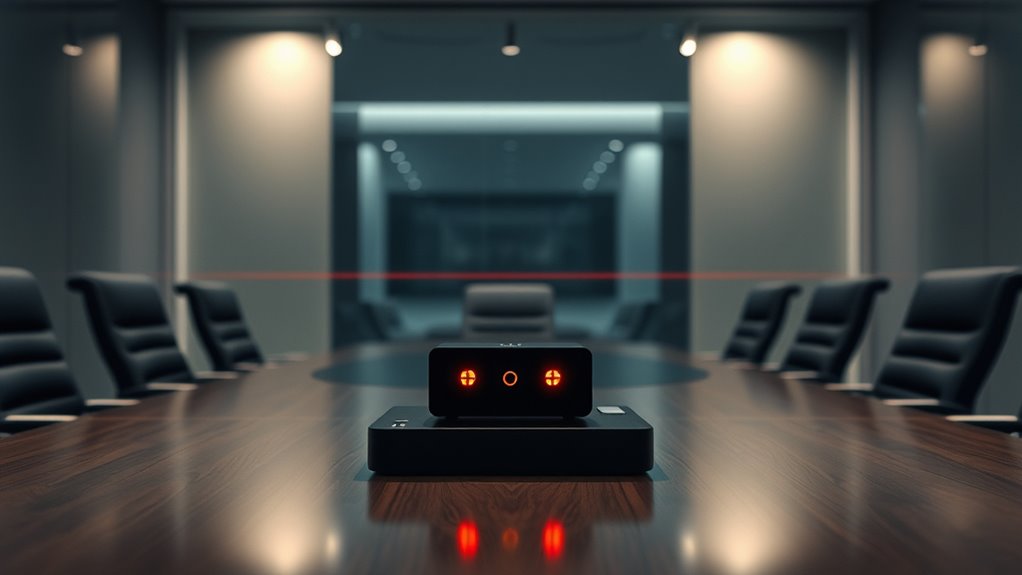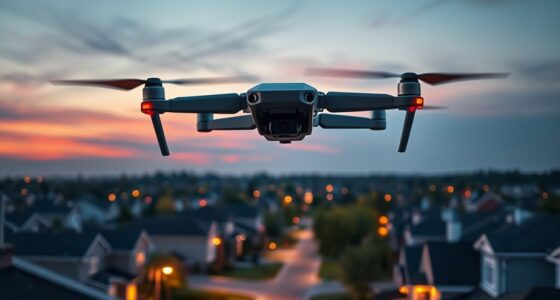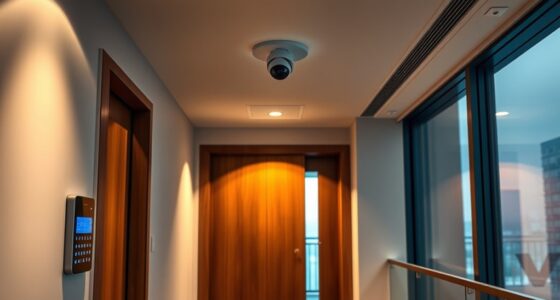To protect against laser microphone eavesdropping, you should secure windows with soundproof treatments and reduce reflective surfaces that could bounce laser signals. Use acoustic barriers and sound masking to hide conversations, and keep environments cluttered to disrupt laser interception. Electronic countermeasures like signal jamming and encryption can also help prevent eavesdropping. Staying aware of emerging surveillance tech and implementing layered security measures will further shield your sensitive information—continue exploring to learn more about safeguarding your space.
Key Takeaways
- Install soundproof window treatments and acoustic panels to prevent sound leakage and reduce reflections that aid laser interception.
- Use laser beam shields, matte surfaces, and strategic furniture placement to disrupt laser paths and minimize surface vibrations.
- Employ electronic countermeasures like signal jamming and optical disruption devices to interfere with laser microphone signals.
- Implement secure, encrypted communication channels and update security protocols regularly to prevent data interception.
- Conduct ongoing security awareness training to identify signs of eavesdropping and adopt proactive environmental and electronic defenses.
Understanding How Laser Microphones Operate
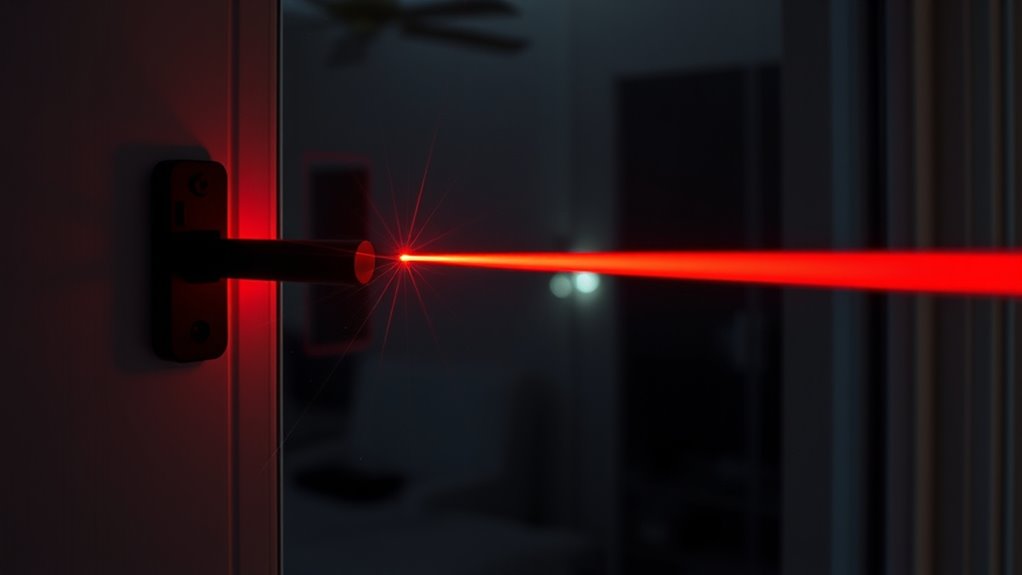
Laser microphones work by detecting tiny vibrations in a surface caused by sound waves. These devices use laser amplification to pick up even the faintest movements, transforming surface vibrations into electrical signals. The laser beam is focused precisely onto a surface, such as a window or wall, to maximize sensitivity. When sound waves cause the surface to vibrate, the laser beam reflects differently, altering its properties. The focused beam captures these subtle changes, which are then amplified and processed to reconstruct the original sound. Beam focusing is essential because it directs the laser’s energy accurately, ensuring high resolution and minimal noise. Understanding this technology helps you recognize how laser microphones can secretly eavesdrop, emphasizing the importance of protective measures. AI vulnerabilities in sensing technology highlight the need for awareness of potential security risks associated with such devices.
Indicators That Might Signal Eavesdropping Activity

You should stay alert for unusual background noises or sudden audio interference during conversations. These anomalies can be signs that someone is intercepting your audio signals. Recognizing these indicators early helps you take action to protect your privacy. Additionally, understanding sound vibrations and their potential effects can improve your awareness of environmental cues that may suggest eavesdropping.
Unusual Background Noises
Unusual background noises can be a telltale sign that your environment is being monitored. You might notice strange hums, clicks, or distant sounds that don’t match your surroundings. These noises can indicate voice modulation or sound masking techniques used to hide eavesdropping activity. For example, an abrupt change in background sound levels or inconsistent audio patterns could suggest someone is trying to cover their listening tracks. If you detect these anomalies, it’s wise to investigate further and consider potential covert monitoring devices. Be attentive to any persistent, unexplained sounds that seem out of place. Recognizing these subtle cues helps you identify possible surveillance efforts and take appropriate measures to protect your privacy from laser microphone eavesdropping. Additionally, understanding Jeep Tuning modifications can help you identify if external environmental factors are affecting your audio environment.
Unexpected Audio Interference
Unexpected audio interference can be a strong sign that your environment is under surveillance. If you notice unusual sounds or disruptions, it could indicate laser targeting or audio frequency interference from a covert microphone. Watch for these signs:
- Sudden, unexplained static or buzzing during conversations
- Intermittent audio dropouts not linked to technical issues
- A faint clicking or high-pitched tone consistent with laser targeting signals
- Background noises that seem out of place or inconsistent with your environment
- Awareness of digital literacy in recognizing and responding to electronic threats can also enhance your security measures.
These disturbances often hint at laser microphone activity, where laser targeting detects sound vibrations, transmitting audio via audio frequency signals. Recognizing these signs helps you identify potential eavesdropping, prompting further security measures.
Physical Barriers and Environment Modification Strategies

You can block laser signals with secure window treatments that absorb or scatter light. Minimizing reflective surfaces in your environment reduces the chances of laser interception. Additionally, controlling environmental noise helps mask any unusual activity, making eavesdropping more difficult. Incorporating active listening exercises can also enhance your awareness of potential breaches and improve your ability to detect covert surveillance.
Secure Window Treatments
Secure window treatments serve as an essential line of defense against laser microphone eavesdropping by physically obstructing and dampening sound waves. They enhance acoustic insulation and improve the effectiveness of soundproof windows. To maximize security, consider:
- Installing heavy, layered curtains that absorb sound energy.
- Using window inserts designed for acoustic insulation.
- Applying window films that reduce reflectivity and sound transmission.
- Adding window plugs or seals for airtight coverage.
These strategies help diminish the chances of sound leakage and laser interception. Effective window treatments not only improve privacy but also complement other security measures. Combining thick curtains with soundproof windows creates a more formidable barrier against eavesdropping attempts, ensuring your sensitive conversations stay private. Implementing soundproofing techniques can further enhance protection by reducing ambient noise and sound transmission through windows.
Minimize Reflective Surfaces
Reducing the number of reflective surfaces in a room can considerably lower the risk of laser microphone eavesdropping. Reflective surfaces, such as glass, polished furniture, and smooth walls, can bounce laser signals, making it easier for attackers to intercept sound. To implement effective environmental modifications, consider replacing or covering shiny surfaces with matte or absorbent materials. Use curtains, carpets, or acoustic panels to diminish reflectivity and absorb laser signals. Rearranging furniture to break up reflective angles also helps. Keep in mind that clutter and surface textures influence reflection patterns. Additionally, understanding AI in Education can help develop smarter security systems that monitor for laser eavesdropping attempts. By minimizing reflective surfaces, you reduce potential reflection points, making laser eavesdropping more difficult. These environmental modifications serve as a practical, passive layer of security, complementing other countermeasures against interception.
Environmental Noise Control
Environmental noise control plays a crucial role in preventing laser microphone eavesdropping by adding physical barriers and modifying the environment to disrupt signal interception. Effective acoustic shielding and laser safety measures can markedly reduce vulnerability. Consider these strategies:
- Install dense, sound-absorbing materials around sensitive areas to block acoustic signals and minimize reflections.
- Use barriers like curtains or panels to absorb laser reflections and prevent unintended signals.
- Adjust room layout to maximize distance from potential laser sources, decreasing interception chances.
- Implement environmental modifications such as sound masking or white noise generators to mask conversations and reduce acoustic signatures.
- Staying informed about cybersecurity vulnerabilities related to electronic surveillance can help identify new threats and adapt security measures accordingly.
These measures help obscure signals, making laser eavesdropping more difficult and enhancing overall security. Proper environmental noise control is essential for safeguarding sensitive communications against laser microphone threats.
Electronic Countermeasures and Signal Disruption Techniques
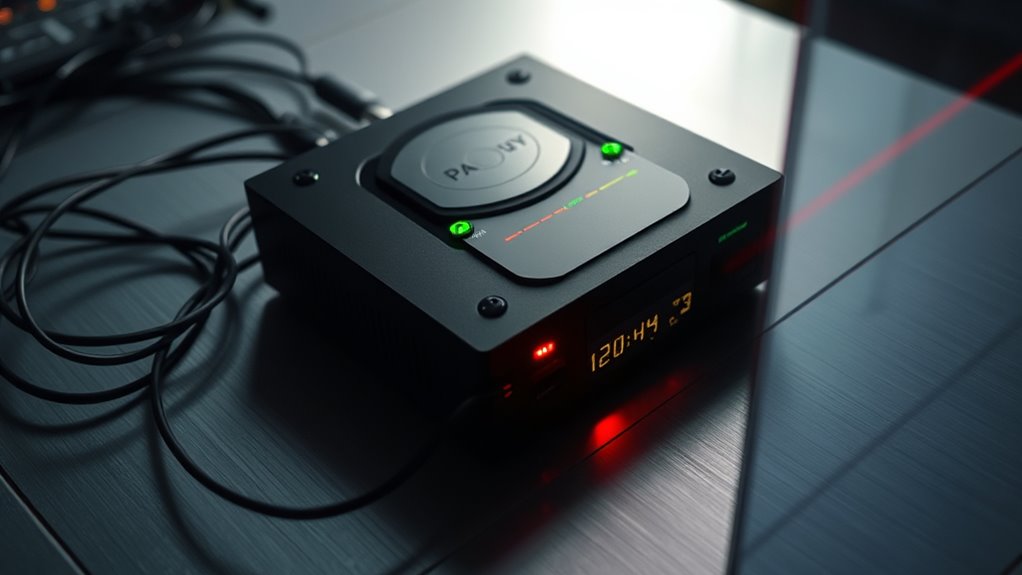
When it comes to protecting sensitive conversations from laser microphone eavesdropping, electronic countermeasures play a crucial role in jamming or disrupting the signals that these devices rely on. You can use signal jamming techniques to interfere with the laser beam or the reflected signal, rendering eavesdropping ineffective. Cryptographic encryption adds an extra layer of security by encrypting audio data, making interception useless unless decrypted. Effective countermeasures include optical jamming devices, which emit disruptive signals, and electronic noise generators that flood the environment with interference. Additionally, understanding the core technology behind laser microphones can help in developing more targeted countermeasures.
Best Practices for Secure Communication in Sensitive Areas
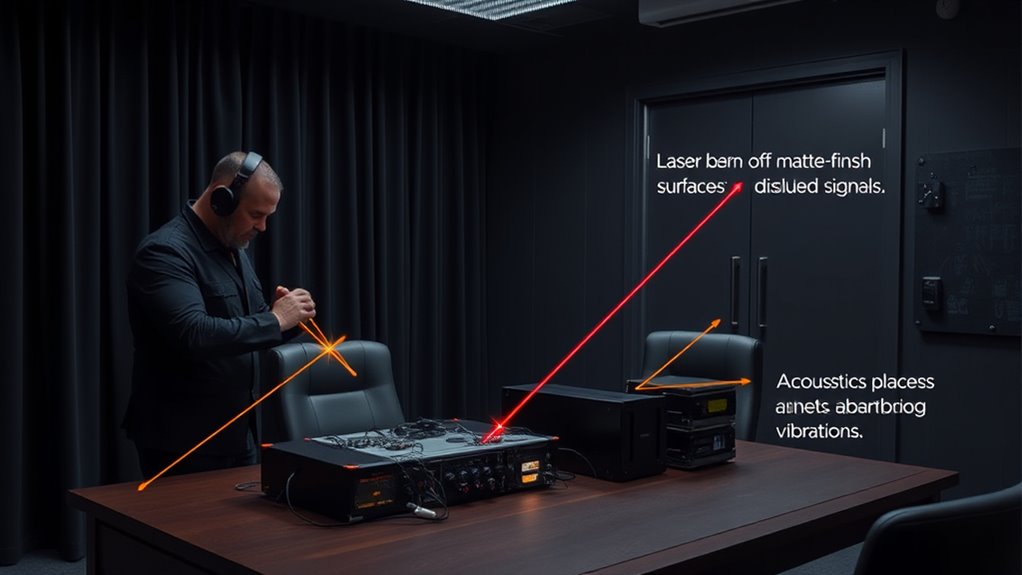
To guarantee secure communication in sensitive areas, implementing robust protocols and technologies is essential. First, use quantum encryption to protect data transmissions against interception. Second, enforce biometric authentication to verify user identities, reducing unauthorized access. Third, establish secure channels with end-to-end encryption to prevent eavesdropping. Fourth, regularly update security protocols to stay ahead of emerging threats. These practices minimize vulnerabilities and ensure confidentiality. Incorporating quantum encryption makes interception virtually impossible, while biometric authentication adds a strong layer of access control. Combining these methods with strict protocol adherence helps safeguard sensitive information from laser microphone and other eavesdropping techniques. Staying proactive with advanced security measures ensures your communication remains confidential in high-risk environments. Additionally, understanding the PlayStation Support Hours, SeaWorld Operating Hours, or Disneyland Opening Hours can assist in planning secure and well-timed communications during operational hours.
Staying Informed About Emerging Surveillance Technologies

Staying informed about emerging surveillance technologies is essential for maintaining security in today’s rapidly evolving landscape. New methods, such as laser interference, can eavesdrop on sensitive conversations from a distance, making constant awareness vital. Techniques like acoustic masking can counteract these threats by disrupting sound waves or signals that covert devices rely on. By understanding these innovations, you can better identify vulnerabilities and implement effective defenses. Regularly update your knowledge through security alerts, industry reports, and expert consultations. Staying ahead of technological advances enables you to adopt proactive measures, such as laser interference detection systems or acoustic masking solutions, to protect your sensitive information. Remaining vigilant ensures you’re prepared to address emerging threats before they compromise your security.
Frequently Asked Questions
How Effective Are Common Household Items in Blocking Laser Microphone Signals?
Household materials can somewhat block laser microphone signals, but their effectiveness varies. Using items like thick curtains, mirrors, or reflective surfaces may cause some signal interference, but they rarely provide reliable protection. For better security, you should consider specialized shielding or signal jamming devices. Relying solely on common household items isn’t enough, as determined eavesdroppers can often bypass these makeshift barriers.
Can Laser Microphone Eavesdropping Be Detected With Standard Security Equipment?
It’s like trying to find a needle in a haystack, but yes, standard security equipment can sometimes detect laser microphone eavesdropping. You can look for signal interference or unusual activity on your audio or RF spectrum analyzers. Detection methods include monitoring for unexpected laser signals, spikes in electromagnetic interference, or using specialized equipment designed for covert surveillance detection. Stay vigilant—such threats are real and evolving.
What Are the Legal Implications of Using Countermeasures Against Eavesdropping?
Using countermeasures against eavesdropping can raise legal concerns because you might cross legal boundaries or face enforcement challenges, especially if the measures interfere with others’ rights or violate laws. You should understand local regulations beforehand to avoid legal trouble. It’s wise to consult legal experts to ensure your security actions stay within legal limits, minimizing enforcement issues and protecting your privacy without unintended legal consequences.
Are There Specific Environments More Vulnerable to Laser Microphone Surveillance?
You’re more vulnerable to laser microphone surveillance in industrial zones and government buildings, where sensitive discussions often occur. These environments attract targeted eavesdroppers seeking classified information. You should be extra cautious, especially in areas with large windows or reflective surfaces that can amplify laser signals. Implementing security measures like shielding windows and monitoring for unusual laser activity helps protect your conversations from covert listening.
How Often Should Security Protocols Be Updated to Counter New Laser Eavesdropping Techniques?
Think of your security as a fortress shadowed by the ever-changing landscape of threats. You should update your protocols at least every six months, or sooner if a new laser eavesdropping technique surfaces. Regular threat assessments help you stay ahead of adversaries, adapting your defenses proactively. Staying vigilant ensures your communication remains secure, much like a castle adapting its defenses to emerging siege tactics.
Conclusion
To truly safeguard your secrets, you must stay vigilant against laser microphone threats—these espionage tools are like silent predators lurking just beyond sight. Implement physical barriers, employ signal disruption, and maintain secure communication practices to outsmart even the most advanced eavesdroppers. Remember, in today’s high-stakes world, staying informed isn’t just smart; it’s your best weapon against invisible threats that could unravel your privacy faster than you can blink. Stay alert, stay protected.
